The sample questions listed on this site are not representative of the full depth or breadth of the
questions in the certification exams. There has been an attempt to create question covering the same
general topic areas and use a similar voice. If you have questions about the topics, please refer to the
product's manuals and / or the training manuals associated with each test. The certification exams
were written for version 4.0 - 4.5 of BIG-IP and 4.0 - 4.5 of 3-DNS. Some features have changed
slightly between versions.
3-DNS Sample Questions (Based on 3-DNS Version 4.2 - 4.5)
1. Setup Utility / FTBU
2. Access
3. Basic DNS
4. Zone Files
5. BIND
6. NameSurfer
7. Server Definition: BIG-IP
8. Server Definition: 3-DNS
9. Server Definition: Host Servers
10. Virtual Server Function
11. Wide-IP Definition
12. Pool Definition
13. Path Probes
14. Server Probes
15. 3dnsmaint
16. Load Balancing
17. Load Balancing
18. Persistence
19. Load Balancing - Special
20. Production Rules
21. Global Variables
22. Notification
23. Notification
24. Management
1. Which settings can be specified during the Setup Utility (aka First Time Boot Utility)?
(choose 3)
a. Default route
b. Self IP addresses
c. WideIP Pool Members
d. Virtual Server addresses
�
e. Password of root account
top Answer Key
2. How can administrative access to the 3-DNS Controller be limited?
(choose 3)
a. HTTPS access can be limited by restricting access only to certain users
b. SSH access can be limited by restricting IP addresses that are allowed to
connect
c. HTTPS access can be limited by restricting IP addresses that are allowed to
connect
d. While SSH access can be limited to one specific network, it cannot be limited
to multiple unique networks.
top Answer Key
3. What are root servers?
(choose 1)
a. All Master DNS servers are known as "root" servers.
b. DNS servers that know the IP addresses of all registered DNS servers.
c. DNS servers that are used by other DNS servers when their initial attempt to
resolve an address fails.
d. The first DNS servers that were setup when the DNS was first implemented.
They are no longer viable.
top Answer Key
4. What information is stored in zone database files?
(choose 3)
a. A point of contact for the zone.
b. The name of the database file for the zone.
c. A list of the secondary servers for the zone.
d. The addresses of the DNS servers for the zone.
e. The optional names that are resolvable for important services in the zone.
top Answer Key
5. When BIND receives a DNS request for a host name for which multiple addresses are
assigned, what is the result?
(choose 1)
a. BIND returns the address of the service that is function the best.
b. BIND picks an address and returns it regardless the viability of the service.
c. BIND returns an address after verifying the chosen address is functioning
properly.
d. BIND returns the address of the service that is closest to the location of the
�
requesting DNS server.
top Answer Key
6. Which are differences when NameSurfer is configured on a 3-DNS Controller?
(choose 2)
a. All zone management configuration errors are eliminated.
b. DNS responses are handled by NameSurfer instead of BIND.
c. Zone file management is handled by NameSurfer instead of text editors.
d. Wide IP names and addresses are automatically entered into appropriate
zone database files.
top Answer Key
7. When a BIG-IP Controller is added to the 3-DNS Controller's list of servers, which of
the following occur?
(choose 3)
a. That BIG-IP Controller's name can now be resolved to its IP address.
b. A Virtual Server managed by the BIG-IP Controller may now be a part of a
Wide-IP.
c. That BIG-IP Controller can be probed using SNMP to determine the
capabilities of its Virtual Servers.
d. The iQuery protocol can be used to share information between the BIG-IP
Controller and the 3-DNS Controller.
e. That BIG-IP Controller may now be tasked to perform path or server probes
and report that information back to the 3-DNS Controller.
top Answer Key
8. When a separate 3-DNS Controller is added to the 3-DNS Controller's list of servers,
which of the following occur?
(choose 2)
a. The new 3-DNS Controller's name can now be resolved to its IP address.
b. A Virtual Server managed by the new 3-DNS Controller may now be a part of
a Wide-IP.
c. The new 3-DNS Controller can be probed using SNMP to determine the
capabilities of its Virtual Servers.
d. The iQuery protocol can be used to share information between the new 3 DNS
Controller and the 3-DNS Controller.
e. The new 3-DNS Controller may now be tasked to perform path or server
probes and report that information back to the 3-DNS Controller.
top Answer Key
9. When a Host Server is added to the 3-DNS Controller's list of servers, which of the
�
following occur?
(choose 2)
a. The Host Server's name can now be resolved to its IP address.
b. A Virtual Server managed by the new Host Server may now be a part of a
Wide-IP.
c. The Host Server can be probed using SNMP to determine the capabilities of
its Virtual Servers.
d. The iQuery protocol can be used to share information between the Host
Server and the 3-DNS Controller.
e. The Host Server may now be tasked to perform path or server probes and
report that information back to the 3-DNS Controller.
top Answer Key
10. From the 3-DNS Controller perspective, which are true concerning Virtual Servers?
(choose 3)
a. 3-DNS Controllers load balance requests sent to Virtual Servers.
b. 3-DNS Controllers use probes to determine the viability of Virtual Servers.
c. 3-DNS Controllers resolve Wide-IP names to IP addresses of Virtual Servers.
d. 3-DNS Controllers use path metrics to determine optimal locations of Virtual
Servers relative to specific local DNS servers.
top Answer Key
11. Which of the following are characteristics of Wide-IPs?
(choose 2)
a. Wide-IP's are associated with one or more pools.
b. Wide-IP's have a load balancing method used to select the optimal pool.
c. Wide-IP's have a name assigned, but that name is not part of any normal
process.
d. The time-to-live field in a Wide-IP's is the maximum number of hops allowed
for that DNS response.
top Answer Key
12. Which of the following are characteristics of 3-DNS Controller Pools?
(choose 2)
a. Pools resolve either to an IP address or to a canonical name.
b. Pools must contain a list of Virtual Servers from the same Data Center.
c. Pools have three levels of Load Balancing defined (Preferred, Alternate,
Fallback).
d. Pools have unique lists of Virtual Servers (Virtual Servers cannot be assigned
to multiple pools).
top Answer Key
�
13. Which of the following can be assigned as a probe to collect Path metrics?
(choose 2)
a. A Host server running an SNMP process.
b. An F5 Networks 3-DNS Controller running the big3d agent.
c. An F5 Networks EDGE-FX Cache running the big3d agent.
d. An F5 Networks BIG-IP Controller not running the big3d agent.
top Answer Key
14. Which of the following can be assigned as a probe to collect SNMP information?
(choose 1)
a. A Host server running an SNMP process.
b. An F5 Networks 3-DNS Controller running the big3d agent.
c. An F5 Networks EDGE-FX Cache running the big3d agent.
d. An F5 Networks BIG-IP Controller not running the big3d agent.
e. All of the above.
top Answer Key
15. Which of the following can be performed using the 3dnsmaint utility?
(choose 3)
a. Exchange SSL authentication information between all 3-DNS controllers.
b. Copy the iQuery Encryption key (F5Key.dat) to all F5 devices defined on a
given 3-DNS controller.
c. Copy the big3d agent to host servers that do not currently contain a copy so
they can perform probes.
d. Copy the appropriate version of the big3d agent to all F5 devices defined on a
given 3-DNS controller.
e. Exchange SSH authentication information between all F5 devices defined on
a given 3-DNS controller.
top Answer Key
16. Which of the following methods of load balancing use SNMP metrics to decide which
virtual server to resolve to?
(choose 1)
a. Hop Count.
b. Round Trip Time.
c. Kilobytes per Second.
d. Virtual Server Capacity.
e. Quality of Host Server Capacity (with SNMP set to 20).
top Answer Key
17. Which of the following methods of load balancing are considered specialized methods
�
of load balancing?
(choose 2)
a. Fastest
b. Random
c. Topology
d. Completion Rate
e. Quality of Service
top Answer Key
18. Which of the following methods of persistence would cause 3-DNS to resolve clients
from a particular LDNS to the same Virtual Server?
(choose 2)
a. Checking the LDNS Round Robin box within a Pool
b. Checking the Persistence box within the Wide-IP configuration
c. Setting Dynamic Persistence for a particular Wide-IP address/name
d. Selecting the Static Persistence as the Preferred Load Balancing method
within a Pool
top Answer Key
19. The Quality of Service load balancing method uses which of the following metrics to
resolve a LDNS to a Virtual Server?
(choose 2)
a. Ratio
b. Virtual Server Completion Comparison
c. Continent from which the client's LDNS originated the name resolution.
d. Hop Count from the LDNS that made the request to each of the Virtual
Servers in a given pool.
top Answer Key
20. Which of the following tasks could be completed using a 3-DNS Production Rule?
(choose 3)
a. Send a message to an administrator when a particular event occurred.
b. Change the Preferred and Fallback method of load balancing at 3am every
morning.
c. Resolve users to a "down site" when maintenance was being performed each
night at 8pm.
d. Automatically create a new WIDE-IP with extra Virtual Servers when the
number of name resolutions reached 3000.
top Answer Key
21. Which of the following global variables would cause 3-DNS to ignore whether a Virtual
�
Server was available prior to resolving requests to it?
(choose 1)
a. ACL Type
b. Drain Requests
c. ECV Data Refresh
d. Check Static Dependencies
e. Check Dynamic Dependencies
top Answer Key
22. Which file has primary responsibility in determining what logs are kept and which
notifications are sent?
(choose 1)
a.
b.
c.
d.
e.
/etc/syslog.conf
/config/bigip.notify
/var/log/messages
/etc/snmptrap.conf
/usr/local/sbin/checktrap.pl
top Answer Key
23. Which methods can a BIG-IP Controller use to notify a remote administrator when
warranted?
(choose 3)
a. e-mail
b. SNMP Puts
c. SNMP Traps
d. Directing logged events to central System Log servers
top Answer Key
24. What can be done from the 3-DNS Configuration Utility?
(choose 4)
a. Create a username account with Read-Only access to the 3-DNS
Configuration Utility
b. Create a username account with Partial access to the 3-DNS Configuration
Utility
c. Create a username account with Full access to the NameSurfer interface
d. Create a username account with Partial access to a particular domain in the
NameSurfer interface
top Answer Key
�
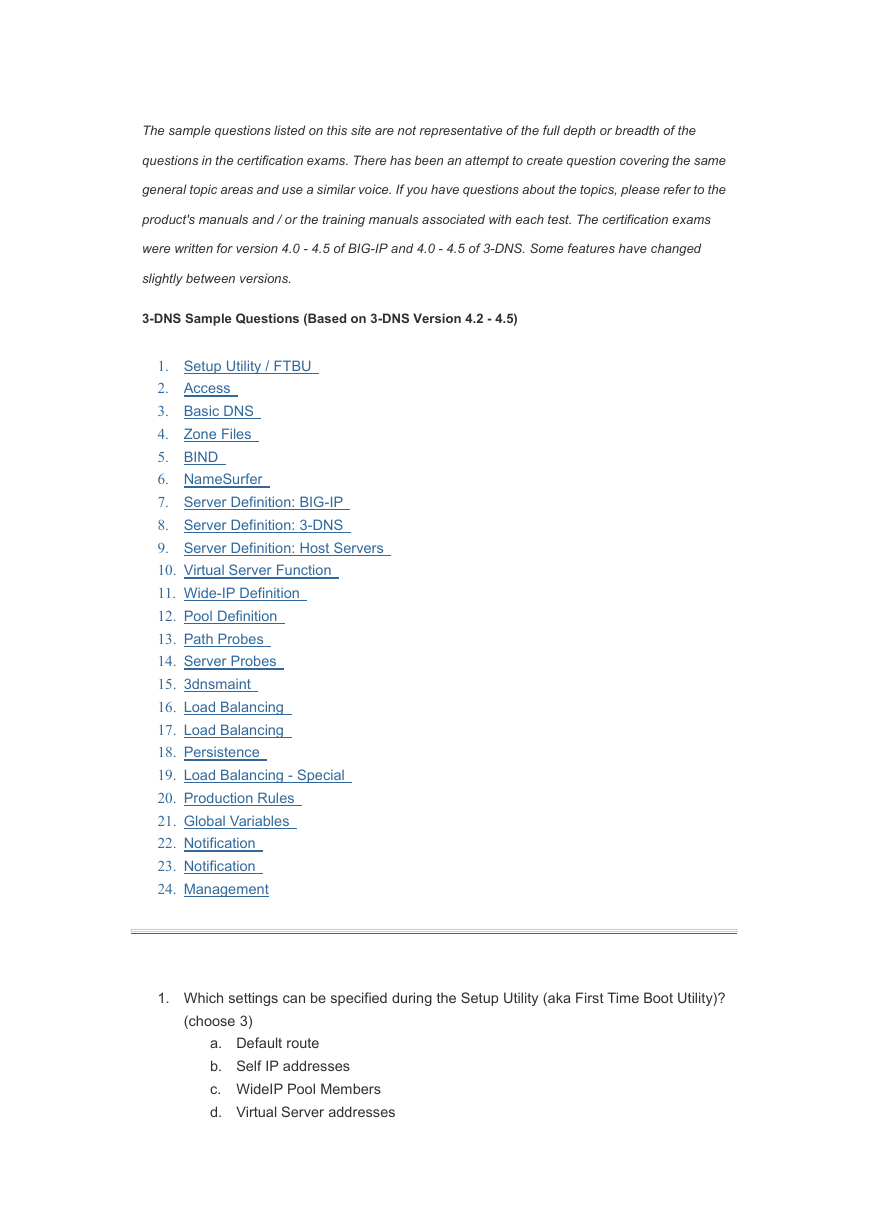
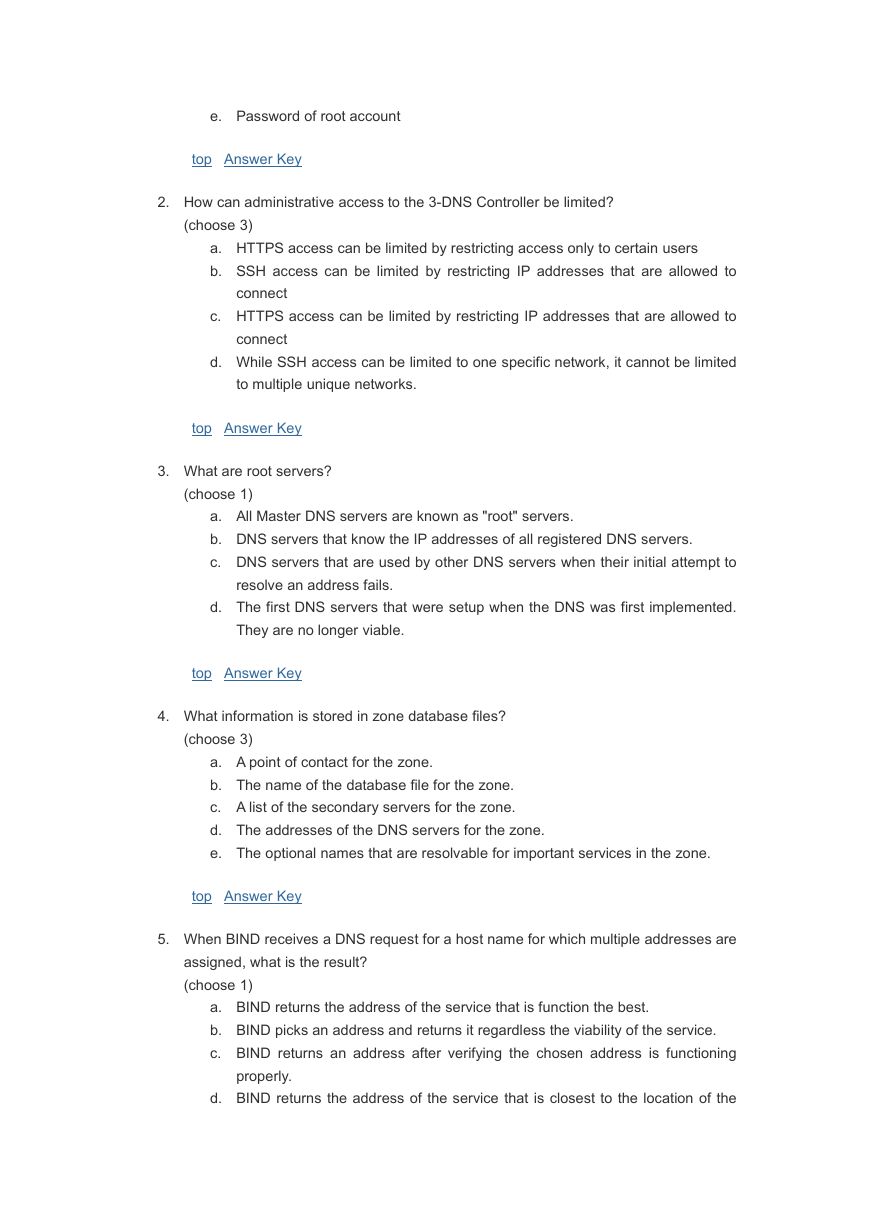
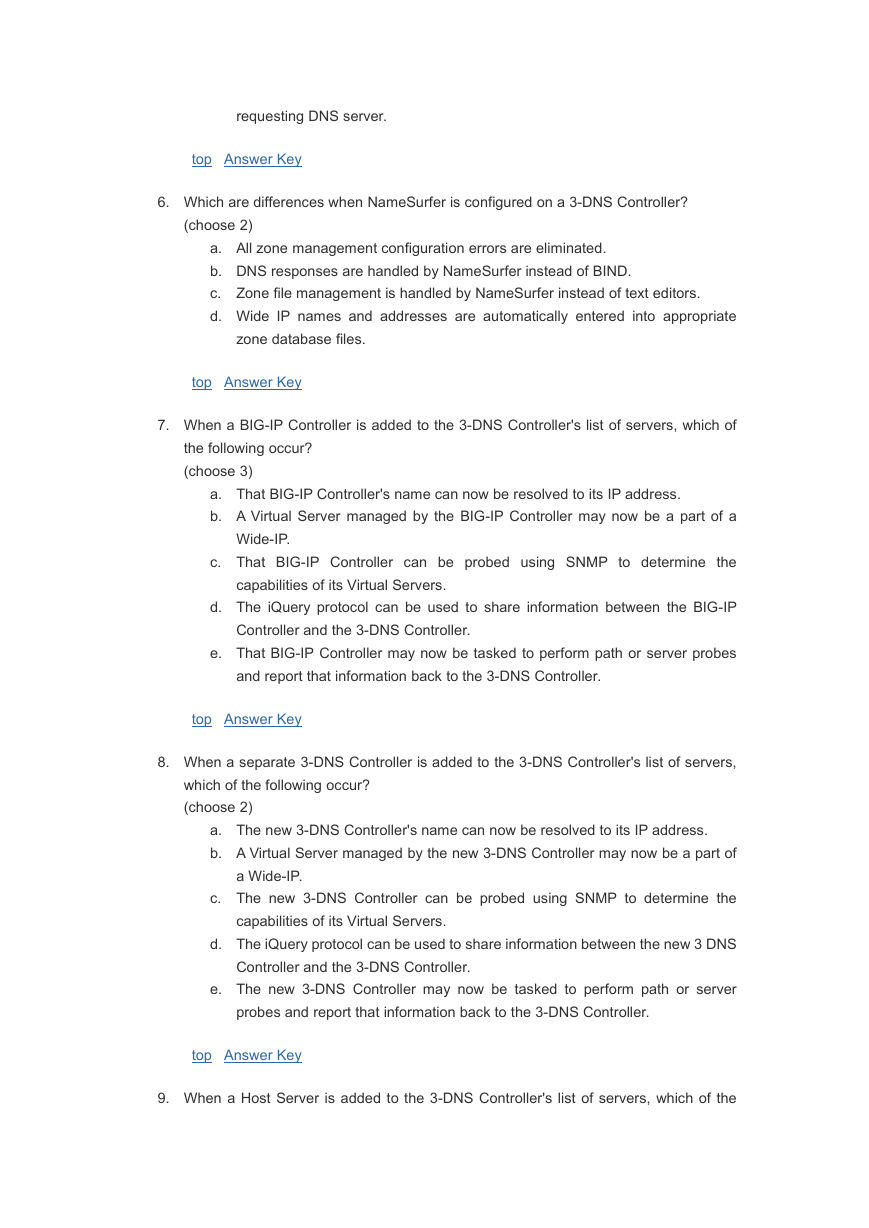
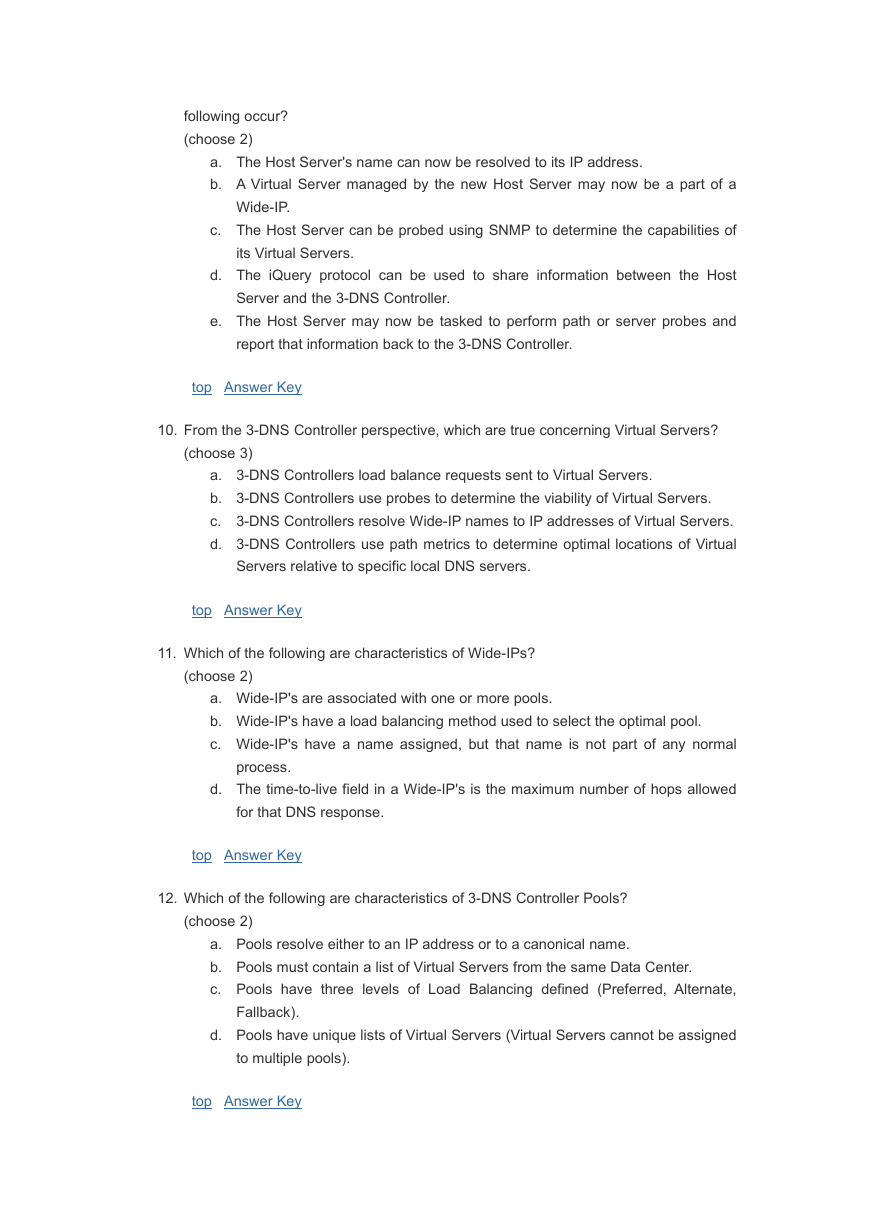

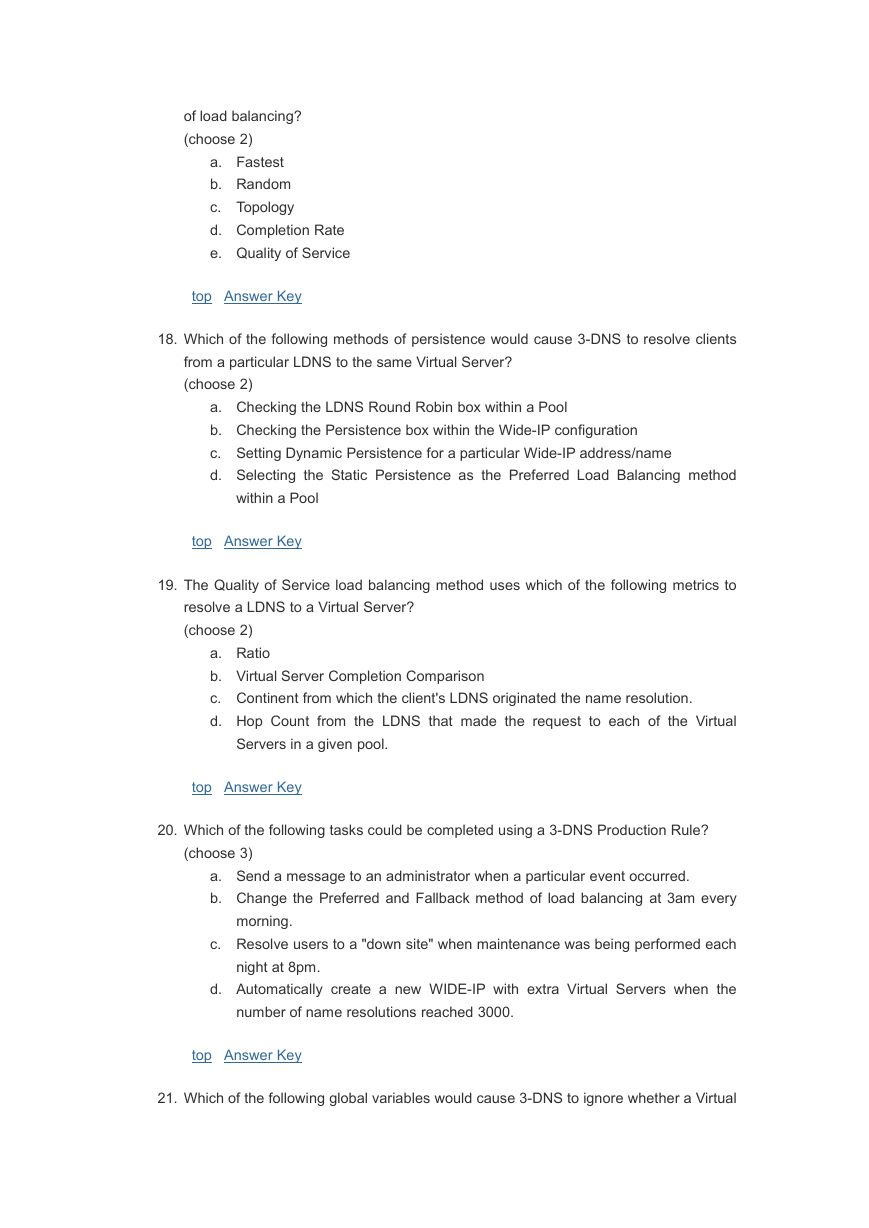








 2023年江西萍乡中考道德与法治真题及答案.doc
2023年江西萍乡中考道德与法治真题及答案.doc 2012年重庆南川中考生物真题及答案.doc
2012年重庆南川中考生物真题及答案.doc 2013年江西师范大学地理学综合及文艺理论基础考研真题.doc
2013年江西师范大学地理学综合及文艺理论基础考研真题.doc 2020年四川甘孜小升初语文真题及答案I卷.doc
2020年四川甘孜小升初语文真题及答案I卷.doc 2020年注册岩土工程师专业基础考试真题及答案.doc
2020年注册岩土工程师专业基础考试真题及答案.doc 2023-2024学年福建省厦门市九年级上学期数学月考试题及答案.doc
2023-2024学年福建省厦门市九年级上学期数学月考试题及答案.doc 2021-2022学年辽宁省沈阳市大东区九年级上学期语文期末试题及答案.doc
2021-2022学年辽宁省沈阳市大东区九年级上学期语文期末试题及答案.doc 2022-2023学年北京东城区初三第一学期物理期末试卷及答案.doc
2022-2023学年北京东城区初三第一学期物理期末试卷及答案.doc 2018上半年江西教师资格初中地理学科知识与教学能力真题及答案.doc
2018上半年江西教师资格初中地理学科知识与教学能力真题及答案.doc 2012年河北国家公务员申论考试真题及答案-省级.doc
2012年河北国家公务员申论考试真题及答案-省级.doc 2020-2021学年江苏省扬州市江都区邵樊片九年级上学期数学第一次质量检测试题及答案.doc
2020-2021学年江苏省扬州市江都区邵樊片九年级上学期数学第一次质量检测试题及答案.doc 2022下半年黑龙江教师资格证中学综合素质真题及答案.doc
2022下半年黑龙江教师资格证中学综合素质真题及答案.doc